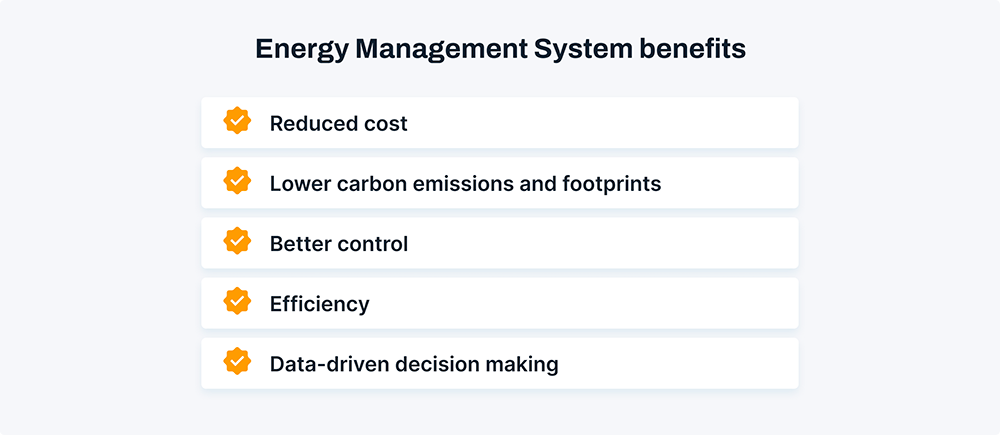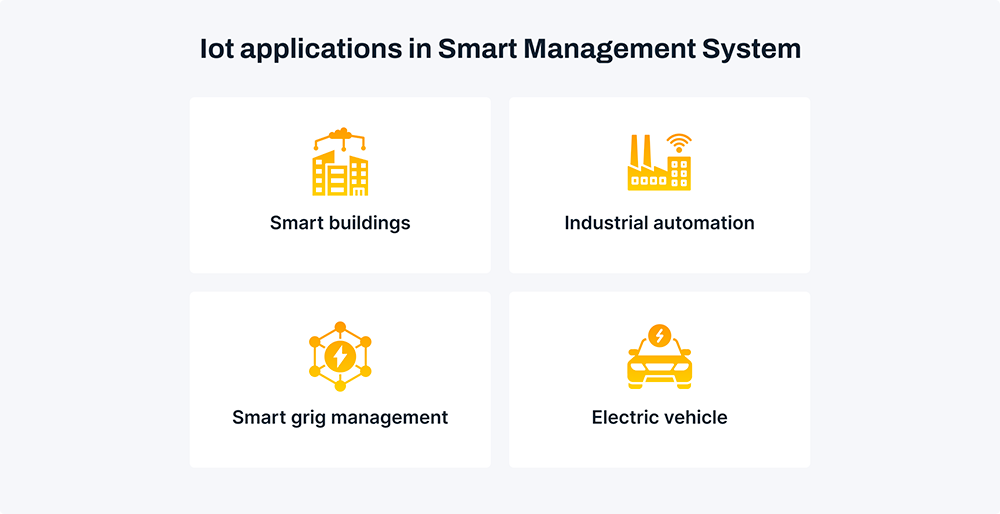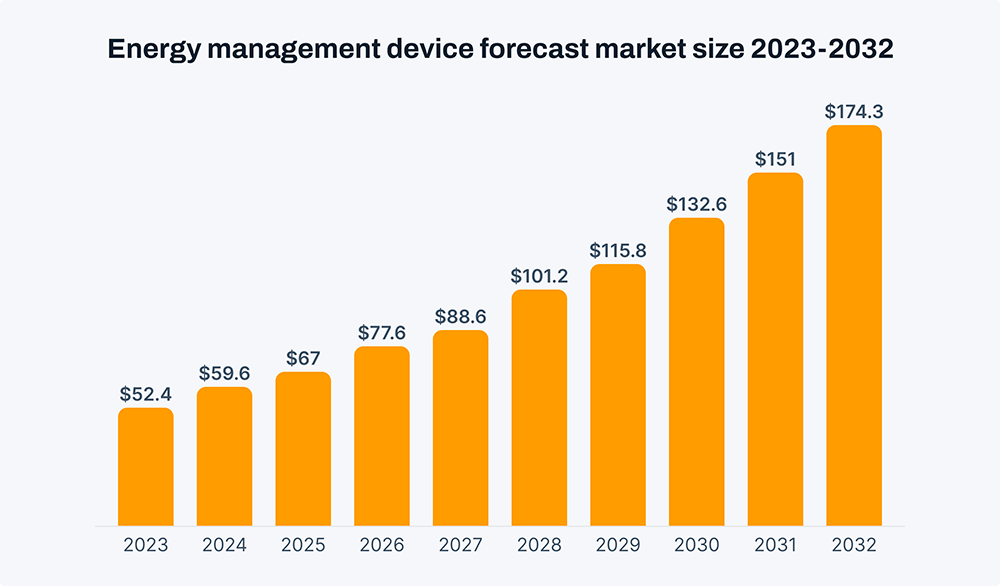Energy Management Systems: Connection with IoT & Statistics
March 12, 2024In today's world, where energy demands are rising, energy markets are unpredictable, and environmental issues loom large, the importance of managing energy efficiently is primary. An energy management system (EMS) emerges as a solution, offering organizations the tools and strategies to optimize energy consumption, reduce costs, enhance sustainability, and comply with regulations.
Integrating IoT technology into energy management devices offers unprecedented opportunities to optimize energy usage, reduce costs, and enhance sustainability efforts. This synergy between EMS and IoT holds immense potential for industries seeking to achieve greater efficiency and sustainability in their energy management practices.
In this article, we'll discuss the benefits of EMS, along with relevant statistics, and explore IoT applications that drive energy efficiency and sustainability initiatives forward.
What is an energy management system?
An energy management system is a set of devices, processes, and procedures designed to help organizations manage energy consumption and decrease energy costs. An EMS typically includes gateway, software, and interface components that monitor and control energy usage in real-time, as well as data analysis tools that help identify areas for improvement.
Gateway
A gateway acts like a central hub, gathering and processing data from different sources. It helps bring together data from various devices and systems, making monitoring and controlling things in IoT setups easier. Gateways usually have strong security to keep data safe at all stages.
Software
Software refers to advanced algorithms that establish rules and limitations to manage energy assets based on specific requirements. For instance, they can prioritize charging devices for maximum self-sufficiency or enforce energy consumption limits according to local grid demands.
Interface
An interface is a user-friendly platform facilitating real-time and historical data visualization, monitoring key performance indicators (KPIs), configuring parameters, and managing energy flows. It provides a comprehensive overview of energy operations, allowing users to make informed decisions and optimize resource utilization.
Read our post-webinar Q&A to find out what solutions KaaIoT can provide in smart energy management automation.
The primary goal of an EMS is to optimize energy usage while maintaining or improving the quality of the services or products provided by the organization. It can be achieved through different strategies, such as implementing energy-efficient technologies, optimizing building systems, and changing employee behavior.
An EMS typically includes several key components, including:
- Energy monitoring and control systems. These systems collect data on energy usage and provide real-time feedback on energy consumption, allowing organizations to identify areas for improvement and make adjustments as needed.
- Energy-efficient technologies. These technologies include LED lighting, energy-efficient HVAC systems, and smart building controls that can help reduce energy consumption.
- Energy management software. Such software helps organizations track and analyze energy usage data, identify trends and patterns, and develop strategies for reducing energy consumption.
- Employee engagement programs. They help educate employees about energy conservation and encourage them to adopt energy-saving behaviors.
Using energy management devices can help organizations reduce energy costs, improve their environmental sustainability, and enhance their reputation as responsible corporate citizens.
Benefits of energy management systems

Reduced cost
An energy management system keeps costs in check by optimizing asset utilization. It strategically draws electricity from grids during low-cost periods, maximizes locally generated power, and aligns consumption with favorable weather and off-peak demand. Dynamic load management and peak shaving further optimize power usage within the existing grid, reducing or eliminating the need for expensive grid expansions and lowering associated fees.
By deploying energy management devices, you can significantly cut operational expenses. The software continuously monitors energy consumption over time, providing valuable insights into usage patterns. With this data, you can make informed decisions to predict costs and optimize energy consumption, leading to substantial savings.
Lower carbon emissions and footprints
In the battle against greenhouse gas emissions, energy management systems play a key role. By enabling demand response, businesses can cut back on energy use during peak hours and reduce reliance on fossil fuels. Plus, load optimization ensures equipment runs efficiently, minimizing waste and emissions.
Energy management systems also integrate renewable energy sources like solar and wind to reduce fossil fuel use. Battery energy storage, managed by EMS, stores excess renewable energy for peak demand times to lower emissions. Data-driven insights continually identify areas for optimization, driving down emissions even more.
Better control
Energy management systems empower managers to promptly respond to alerts and optimize energy consumption through comprehensive data analysis and intuitive visualization tools. These systems serve as centralized hubs for various operational tasks, allowing companies to streamline processes and address issues efficiently.
By identifying patterns and anomalies in energy usage, businesses can proactively mitigate risks and optimize performance across multiple facets of operations, leading to improved efficiency and cost savings. Advanced energy control systems enable predictive maintenance and automated adjustments by enhancing operational agility and resilience.
Efficiency
Starting a software development project to craft a customized energy management solution can completely transform how you oversee and improve energy usage. It allows you to monitor and adjust energy consumption more efficiently. By leveraging advanced analytics and machine learning algorithms, your custom solution can detect inconsistencies, excesses, or unnecessary energy usage patterns, providing actionable insights to enhance efficiency.
Such a system can offer predictive capabilities, forecasting energy demand and enabling proactive measures to mitigate potential waste or inefficiencies. With customizable features and real-time monitoring capabilities, your custom energy management solution empowers you to make informed decisions, optimize resource allocation, and drive sustainable practices across your operations.
Data-driven decision making
Having real-time insights into your energy consumption enables data decision-making. An advanced energy management system provides detailed data on energy usage across your organization, aiding in resource allocation and optimization. It also supports proactive strategies to boost efficiency and cut costs.
Integration of IoT into energy management systems
Energy management systems integrating with IoT have changed how organizations monitor, analyze, and optimize energy use. IoT devices and advanced analytics drive efficiency, cost savings, and sustainability in energy management.
Predictive maintenance
It is possible to predict equipment failures before they occur, enabling timely repairs and minimizing downtime with IoT. This results in reduced operational expenses and improved overall efficiency.
Demand response capabilities
IoT allows for dynamic load shedding during peak demand periods, helping organizations avoid expensive penalties from utility companies and maintain a stable electricity supply.
Smart metering
IoT-enabled meters enable accurate tracking of energy usage across different locations, making it easier to allocate resources effectively and detect anomalies.
IoT data analytics
IoT generates vast amounts of data, which can be analyzed using machine learning algorithms to uncover hidden patterns and correlations between energy usage and external factors.
IoT applications in energy management systems

Smart buildings
Smart buildings and IoT technologies represent the forefront of modern building management. These systems utilize IoT devices like sensors, actuators, and smart meters to gather real-time data on building parameters such as energy consumption, occupancy levels, indoor air quality, temperature, and lighting conditions.
The EMS then processes this data, utilizing advanced analytics to optimize building operations, enhance energy efficiency, and improve occupant comfort. By leveraging predictive analytics and machine learning algorithms, energy management devices can forecast energy demands, identify potential energy-saving opportunities, and automatically adjust building systems for optimal efficiency.
Industrial automation
In manufacturing, EMS harnesses industrial IoT sensors and actuators to collect real-time data on equipment performance, energy use, and production metrics. This data is analyzed to optimize energy consumption and prevent equipment failures through predictive maintenance.
Integrating industrial automation systems like SCADA and PLCs ensures that energy-efficient practices are seamlessly incorporated into manufacturing processes. EMS dynamically adjusts equipment settings, manages power usage during peak demand, and promotes renewable energy adoption.
Smart grid management
Integrating EMS into smart grid management enhances energy distribution and consumption, especially in areas with high renewable energy and electric vehicle adoption. IoT sensors gather real-time data on grid performance and electricity usage.
EMS employs advanced analytics to predict energy demand, balance supply, and detect grid vulnerabilities. It enables dynamic pricing, demand response, and grid stabilization. Smart grid technology integrated with EMS utilities gains the ability to monitor and control operations remotely, enabling proactive management and rapid fault detection for enhanced grid reliability.
Electric vehicle
EMS optimizes electric vehicle charging by scheduling it during low-demand periods, cutting costs for users and utilities. It also prioritizes charging with renewable energy, enhancing sustainability. Also, EMS supports demand response, managing peak demand by adjusting charging rates or delaying charging during high-demand periods.
Statistics on energy management devices
Energy management devices are instrumental in slashing energy costs globally. Governments worldwide, both in established and emerging economies, are rolling out various programs and policies to promote the adoption of these systems. Once regarded as innovative technologies in the power and energy sectors, they are now widely adopted by small and medium enterprises in many industries.
With their myriad benefits driving demand, energy management devices are experiencing swift uptake—technological advancements and substantial government investments in their development further fuel their growth trajectory. In response to mounting concerns over pollution and carbon emissions, the market for energy management systems continues to expand rapidly. Government initiatives emphasizing the importance of energy consumption are also bolstering market growth.
The energy management devices market is experiencing significant growth and is anticipated to continue expanding in the coming years. The global energy management devices market was valued at $52 billion in 2023 and is estimated to reach approximately $174.30 billion by 2032, with a compound annual growth rate (CAGR) of 14.30% between 2023 and 2032.

The energy management systems market in the United States soared to indicate a robust growth trajectory, with expectations that by 2032, the market will expand significantly to reach approximately $42.33 billion. This growth represents a CAGR of about 14.20% from 2023 to 2032.
Asia-Pacific led the energy management systems market in 2022, fueled by the pressing need for electricity in underserved areas. The rapid industrial and urban expansion further propelled market growth. Significant investments in energy management system development also bolstered the market across the region.
North America is poised for rapid growth in the forecast period 2023-2032, spurred by stringent government regulations on energy storage and management. Supportive policies further incentivize the adoption of energy systems, propelling the market's expansion in the region.
Conclusion
The integration of IoT technology with energy management systems represents a significant advancement in energy efficiency and sustainability efforts across various industries. By leveraging IoT devices and advanced analytics, EMS enables real-time monitoring, optimization, and control of energy consumption, contributing to cost reduction, emissions reduction, and grid stability.
The global energy management systems market is experiencing rapid growth, driven by increasing energy demand, regulatory mandates, and technological advancements. With continued investment and innovation, EMS integrated with the IoT is poised to shape the future of energy management worldwide.
Are you looking for energy management system solutions for your organization? Contact us, and Kaa experts will figure out the best way to accommodate your needs.
FAQ
What is energy management equipment?
Energy management equipment refers to devices and systems designed to monitor, control, and optimize energy usage in various settings, such as buildings, industrial facilities, and transportation.
What is energy management in the industry?
Energy management in the industry encompasses various strategies, systems, and practices geared towards optimizing energy usage, cutting costs, and mitigating environmental impact throughout manufacturing and production processes.
How is IoT used in energy?
IoT is used in energy to monitor, control, and optimize energy usage in real-time. IoT sensors collect data on energy consumption, production, and distribution, enabling efficient management, predictive maintenance, and demand response strategies.
Does IoT increase energy efficiency?
IoT increases energy efficiency by providing real-time data on energy usage, enabling proactive management, automated optimization, and predictive maintenance, ultimately reducing waste and improving overall efficiency.
